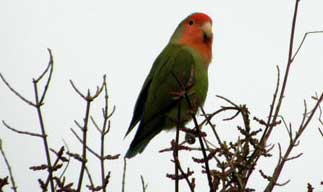BY LINDA BENTLEY | FEBRUARY 13, 2013
Peach-faced Lovebirds thriving in Cave Creek
While caged birds are often accidentally released into the wild, Peach-faced Lovebirds are notorious for being expert escape artists
 CAVE CREEK – Wildlife sightings are enjoyable and common in Cave Creek. Spotting a cardinal, Harris’ Hawk, Great Horned Owl, bobcat, javelina, coyote, Mule Deer and more is a joy shared by many as evidenced by our reader photos each week.
CAVE CREEK – Wildlife sightings are enjoyable and common in Cave Creek. Spotting a cardinal, Harris’ Hawk, Great Horned Owl, bobcat, javelina, coyote, Mule Deer and more is a joy shared by many as evidenced by our reader photos each week.
On a morning walk last week I spotted two very colorful little birds I couldn’t readily identify. But they didn’t sit still long enough to get a photograph nor were they close enough to identify.
The following day, I spotted one again in the same neighborhood on the west side of Black Mountain and was lucky enough to snap its picture.
It turned out to be a Peach-faced Lovebird, also known as a Rosy-faced Lovebird.
The Peach-faced Lovebird, one of nine species of small African parrots of the genus Agapornis (Agapornis roseicollis), is native to Southwestern Africa in the Namib Desert and arid regions of Namibia and Angola.
While caged birds are often accidentally released into the wild, Peach-faced Lovebirds are notorious for being expert escape artists.
A website (e-peachface.com) started over a decade ago allows people to place a location marker on a map when these little birds are spotted, showing numerous sightings in the Phoenix metropolitan area, including Cave Creek.
These lovebirds have established themselves in Tucson as well.
While the Peach-faced Lovebird is not known as a talker, it does enjoy learning tricks.
Small in size at about 6.5 inches, the Peach-faced Lovebird, as a pet, is said to be big on personality and one that enjoys interacting with its owner and playing with new toys.
In the wild in Arizona, the Peach-faced Lovebird seems to enjoy feeding on dry Mesquite seeds.
Most birds have differentiating features to determine sex, such as males being the more colorful of the two.
That is not the case with lovebirds. Both male and female have identical plumage.
Females, however, are noted for tearing raw materials into long strips, weaving them into their backs and flying substantial distances to build a nest. Following the nest building habits is generally the best way to determine which birds are the females.
Called lovebirds for their habit of sleeping side by side with their heads turned toward each other, Peach-faced Lovebirds are also known to be loud, making harsh, shrieking calls in the wild and a loud constant chirper as a pet.
As pets, they can be kept alone or in pairs but tend to bond toward an individual, whether human or avian.
They can also be aggressive and two lovebirds may need to be separated if they don’t get along.
Peach-faced Lovebird pets are known for their frequent escapes, living with feral birds and adapting well to the arid climate in both urban and rural areas of metropolitan Phoenix in a variety of habitats, so long as they are near a water source.
Trapping for the pet trade has reduced the populations in some of its native habitat but numbers may have increased in others due to the creation of man-made water sources and artificial structures that provide nesting sites.
Since tracking and mapping began in 1999, it appears the Peach-faced Lovebird continues to thrive in the wild in Arizona.




